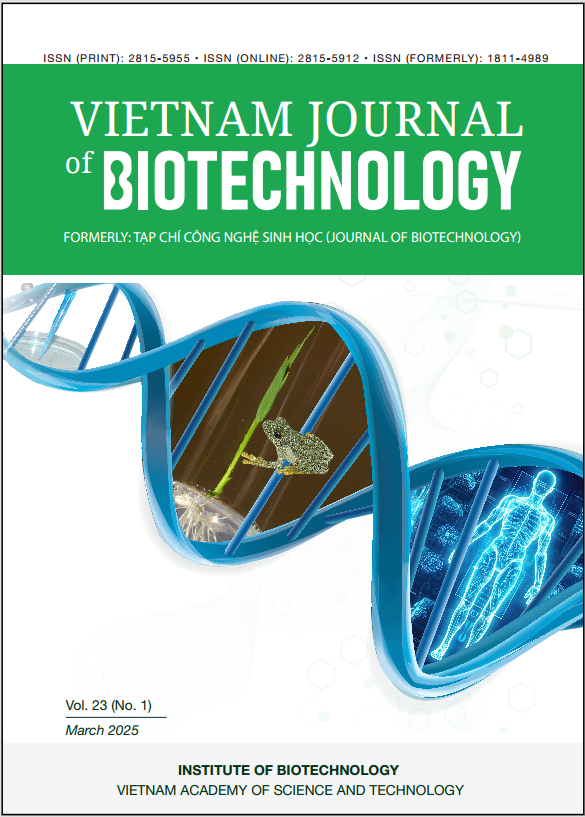Development of a Pichia pastoris strain for secretory production of recombinant alkaline phytase
Author affiliations
DOI:
https://doi.org/10.15625/vjbt-21940Keywords:
alkaline phytase, aquaculture feed enzyme, Pichia pastoris, phytate hydrolysis, secretion expressionAbstract
Recombinant phytase produced by the Pichia pastoris expression system is widely utilized in the food and animal feed industries. Alkaline phytases are preferred as aquafeed supplements due to their efficiency in degrading antinutritional phytates. In this study, we engineered a recombinant P. pastoris strain to secrete alkaline phytase derived from Bacillus subtilis, with the aim of further application in the aquafeed industry. The recombinant vector, pPICZαA-phy, carrying the phytase-encoding gene (phy), was successfully constructed and integrated into the genome of P. pastoris X33. The resulting recombinant strain, P. pastoris X33::phy, exhibited a methanol-utilization positive phenotype (Mut+) and utilized methanol as a carbon source. Secretion of the recombinant alkaline phytase by P. pastoris X33::phy was confirmed through western blot analysis. Enzymatic activity assay demonstrated that this engineered yeast strain is capable of secreting alkaline phytase, which was able to hydrolyze phytate under mildly alkaline conditions (pH 7.5). These results suggest the potential of this strain for industrial applications, particularly in aquafeed production.
Downloads
References
Ahmad, M., Hirz, M., Pichler, H., & Schwab, H. (2014). Protein expression in Pichia pastoris: recent achievements and perspectives for heterologous protein production. Applied Microbiology and Biotechnology, 98(12), 5301–5317. https://doi.org/10.1007/s00253-014-5732-5
Athmaram, T. N., Saraswat, S., Singh, A. K., Rao, M. K., Gopalan, N., Suryanarayana, V. V. S., et al. (2012). Influence of copy number on the expression levels of pandemic influenza hemagglutinin recombinant protein in methylotrophic yeast Pichia pastoris. Virus Genes, 45(3), 440–451. https://doi.org/10.1007/s11262-012-0809-7
Batt, C. A. (2014). Pichia pastoris. In Encyclopedia of Food Microbiology (Vol. 3, pp. 42–46). Elsevier. https://doi.org/10.1016/B978-0-12-384730-0.00254-8
Chen, C.-C., Wu, P.-H., Huang, C.-T., & Cheng, K.-J. (2004). A Pichia pastoris fermentation strategy for enhancing the heterologous expression of an Escherichia coli phytase. Enzyme and Microbial Technology, 35(4), 315–320. https://doi.org/10.1016/j.enzmictec.2004.05.007
Cheng, W., Chiu, C.-S., Guu, Y.-K., Tsai, S.-T., & Liu, C.-H. (2013). Expression of recombinant phytase of Bacillus subtilis E20 in Escherichia coli HMS 174 and improving the growth performance of white shrimp, Litopenaeus vannamei, juveniles by using phytase-pretreated soybean meal-containing diet. Aquaculture Nutrition, 19(2), 117–127. https://doi.org/10.1111/j.1365-2095.2012.00946.x
Choi, J. H., & Lee, S. Y. (2004). Secretory and extracellular production of recombinant proteins using Escherichia coli. Applied Microbiology and Biotechnology, 64(5), 625–635. https://doi.org/10.1007/s00253-004-1559-9
Coban, H. B., & Demirci, A. (2017). Phytase as a diet ingredient: from microbial production to its applications in food and feed industry. In Microbial Production of Food Ingredients and Additives (pp. 33–55). Elsevier. https://doi.org/10.1016/B978-0-12-811520-6.00002-7
Crouch, S. R., & Malmstadt, H. V. (1967). Mechanistic investigation of molybdenum blue method for determination of phosphate. Analytical Chemistry, 39(10), 1084–1089. https://doi.org/10.1021/ac60254a027
Daly, R., & Hearn, M. T. W. (2005). Expression of heterologous proteins in Pichia pastoris: a useful experimental tool in protein engineering and production. Journal of Molecular Recognition, 18(2), 119–138. https://doi.org/10.1002/jmr.687
FAO. (2024). The State of World Fisheries and Aquaculture 2024. https://doi.org/10.4060/cd0683en
Gatlin, D. M., Barrows, F. T., Brown, P., Dabrowski, K., Gaylord, T. G., Hardy, R. W., et al. (2007). Expanding the utilization of sustainable plant products in aquafeeds: a review. Aquaculture Research, 38(6), 551–579. https://doi.org/10.1111/j.1365-2109.2007.01704.x
Guerrero-Olazarán, M., Rodríguez-Blanco, L., Carreon-Treviño, J. G., Gallegos-López, J. A., & Viader-Salvadó, J. M. (2010). Expression of a Bacillus phytase C gene in Pichia pastoris and properties of the recombinant enzyme. Applied and Environmental Microbiology, 76(16), 5601–5608. https://doi.org/10.1128/AEM.00762-10
Guo, M., Hang, H., Zhu, T., Zhuang, Y., Chu, J., & Zhang, S. (2008). Effect of glycosylation on biochemical characterization of recombinant phytase expressed in Pichia pastoris. Enzyme and Microbial Technology, 42(4), 340–345. https://doi.org/10.1016/j.enzmictec.2007.10.013
Haros, M., Bielecka, M., & Sanz, Y. (2005). Phytase activity as a novel metabolic feature in Bifidobacterium. FEMS Microbiology Letters, 247(2), 231–239. https://doi.org/10.1016/j.femsle.2005.05.008
Helian, Y., Gai, Y., Fang, H., Sun, Y., & Zhang, D. (2020). A multistrategy approach for improving the expression of Escherichia coli phytase in Pichia pastoris. Journal of Industrial Microbiology and Biotechnology, 47(12), 1161–1172. https://doi.org/10.1007/s10295-020-02311-6
Hmida-Sayari, A., Elgharbi, F., Farhat, A., Rekik, H., Blondeau, K., & Bejar, S. (2014). Overexpression and biochemical characterization of a thermostable phytase from Bacillus subtilis US417 in Pichia pastoris. Molecular Biotechnology, 56(9), 839–848. https://doi.org/10.1007/s12033-014-9764-y
Huang, H., Shao, N., Wang, Y., Luo, H., Yang, P., Zhou, Z., et al. (2009). A novel beta-propeller phytase from Pedobacter nyackensis MJ11 CGMCC 2503 with potential as an aquatic feed additive. Applied Microbiology and Biotechnology, 83(2), 249–259. https://doi.org/10.1007/s00253-008-1835-1
Kleiner‐Grote, G. R. M., Risse, J. M., & Friehs, K. (2018). Secretion of recombinant proteins from Escherichia coli. Engineering in Life Sciences, 18(8), 532–550. https://doi.org/10.1002/elsc.201700200
Krainer, F. W., Dietzsch, C., Hajek, T., Herwig, C., Spadiut, O., & Glieder, A. (2012). Recombinant protein expression in Pichia pastoris strains with an engineered methanol utilization pathway. Microbial Cell Factories, 11(1), 22. https://doi.org/10.1186/1475-2859-11-22
Kumar, V., Sangwan, P., Verma, A. K., & Agrawal, S. (2014). Molecular and biochemical characteristics of recombinant β-propeller phytase from Bacillus licheniformis strain PB-13 with potential application in aquafeed. Applied Biochemistry and Biotechnology, 173(2), 646–659. https://doi.org/10.1007/s12010-014-0871-9
Kumar, V., Sinha, A. K., Makkar, H. P. S., De Boeck, G., & Becker, K. (2012). Phytate and phytase in fish nutrition. Journal of Animal Physiology and Animal Nutrition, 96(3), 335–364. https://doi.org/10.1111/j.1439-0396.2011.01169.x
Lei, X. G., & Porres, J. M. (2003). Phytase enzymology, applications, and biotechnology. Biotechnology Letters, 25(21), 1787–1794. https://doi.org/10.1023/A:1026224101580
Lemos, D., & Tacon, A. G. J. (2017). Use of phytases in fish and shrimp feeds: a review. Reviews in Aquaculture, 9(3), 266–282. https://doi.org/10.1111/raq.12138
Li, Z., Zhao, A., Wang, X., Jin, X., Li, J., & Yu, M. (2013). Cloning, overexpression, and functional characterization of a phytase from the genus Bacillus. Microbial Physiology, 23(3), 193–202. https://doi.org/10.1159/000347027
Mamat, U., Wilke, K., Bramhill, D., Schromm, A. B., Lindner, B., Kohl, T. A., et al. (2015). Detoxifying Escherichia coli for endotoxin-free production of recombinant proteins. Microbial Cell Factories, 14(1), 57. https://doi.org/10.1186/s12934-015-0241-5
Mansur, M., Cabello, C., Hernández, L., País, J., Varas, L., Valdés, J., et al. (2005). Multiple gene copy number enhances insulin precursor secretion in the yeast Pichia pastoris. Biotechnology Letters, 27(5), 339–345. https://doi.org/10.1007/s10529-005-1007-7
Mastropietro, G., Aw, R., & Polizzi, K. M. (2021). Expression of proteins in Pichia pastoris. In Methods in Enzymology (Vol. 660, pp. 53–80). Elsevier. https://doi.org/10.1016/bs.mie.2021.07.004
Melcion, J. P., & Poel, A. F. B. van der. (1993). Process technology and antinutritional factors: principles, adequacy and process optimization. In A. F. B. van der Poel (Ed.), Recent advances of research in antinutritional factors in legume seeds (pp. 419–434). EAAP Publ. 70, Wageningen Press.
Mukesh, P., Suma, S., Singaracharya, M. A., & Lakshmipathi, V. (2004). Isolation of phytate-hydrolysing microbial strains from traditional waste water of rice fermentation and liquid cattle feeds. World Journal of Microbiology and Biotechnology, 20(5), 531–534. https://doi.org/10.1023/B:WIBI.0000040403.23667.68
Nam, S.-J., Kim, Y.-O., Ko, T.-K., Kang, J.-K., Chun, K.-H., Auh, J.-H., et al. (2014). Molecular and biochemical characteristics of β-propeller phytase from marine Pseudomonas sp. BS10-3 and its potential application for animal feed additives. Journal of Microbiology and Biotechnology, 24(10), 1413–1420. https://doi.org/10.4014/jmb.1407.07063
New, M. B., & Wijkström, U. N. (2002). Use of fishmeal and fish oil in aquafeeds further thoughts on the fishmeal trap. FAO Fisheries Circular, 975(975).
Nordén, K., Agemark, M., Danielson, J. Å., Alexandersson, E., Kjellbom, P., & Johanson, U. (2011). Increasing gene dosage greatly enhances recombinant expression of aquaporins in Pichia pastoris. BMC Biotechnology, 11(1), 47. https://doi.org/10.1186/1472-6750-11-47
Oh, B.-C., Choi, W.-C., Park, S., Kim, Y. -o., & Oh, T.-K. (2004). Biochemical properties and substrate specificities of alkaline and histidine acid phytases. Applied Microbiology and Biotechnology, 63(4), 362–372. https://doi.org/10.1007/s00253-003-1345-0
Potter, H. (1993). [34] Application of electroporation in recombinant DNA technology (Vol. 217, pp. 461–478). Methods in Enzymology, Elsevier. https://doi.org/10.1016/0076-6879(93)17084-I
Rodriguez, E., Han, Y., & Lei, X. G. (1999). Cloning, sequencing, and expression of an Escherichia coli acid phosphatase/phytase gene (appA2) isolated from pig colon. Biochemical and Biophysical Research Communications, 257(1), 117–123. https://doi.org/10.1006/bbrc.1999.0361
Roy, T., Banerjee, G., Dan, S. K., Ghosh, P., & Ray, A. K. (2014). Improvement of nutritive value of sesame oilseed meal in formulated diets for rohu, Labeo rohita (Hamilton), fingerlings after fermentation with two phytase-producing bacterial strains isolated from fish gut. Aquaculture International, 22(2), 633–652. https://doi.org/10.1007/s10499-013-9691-0
Singh, N., Kuhar, S., Priya, K., Jaryal, R., & Yadav, R. (2018). Phytase: the feed enzyme, an overview. In Advances in Animal Biotechnology and its Applications (pp. 269–327). Springer Singapore. https://doi.org/10.1007/978-981-10-4702-2_17
Stahl, C. H., Wilson, D. B., & Lei, X. G. (2003). Comparison of extracellular Escherichia coli AppA phytases expressed in Streptomyces lividans and Pichia pastoris. Biotechnology Letters, 25, 827–831. https://doi.org/10.1023/A:1023568826461
Thao, D. T. P., Trinh, N. T. M., Nghia, N. H., & Thuoc, T. L. (2018). Mixture of cell extract and method for site-directed cloning. Patent Application No. US-2020131521-A1.
Tran Thi, T., & Mai Thi, N. (2019). Expression and purificaton of a recombinant phytase originated from Bacillus subtilis in batch cultivation of Escherichia coli. Journal of Science Natural Science, 64(3), 123–132. https://doi.org/10.18173/2354-1059.2019-0015
Tyo, K. E. J., Liu, Z., Magnusson, Y., Petranovic, D., & Nielsen, J. (2014). Impact of protein uptake and degradation on recombinant protein secretion in yeast. Applied Microbiology and Biotechnology, 98(16), 7149–7159. https://doi.org/10.1007/s00253-014-5783-7
Vielma, J., Lall, S. P., Koskela, J., Schöner, F.-J., & Mattila, P. (1998). Effects of dietary phytase and cholecalciferol on phosphorus bioavailability in rainbow trout (Oncorhynchus mykiss). Aquaculture, 163(3–4), 309–323. https://doi.org/10.1016/S0044-8486(98)00240-3
Vogl, T., Gebbie, L., Palfreyman, R. W., & Speight, R. (2018). Effect of plasmid design and type of integration event on recombinant protein expression in Pichia pastoris. Applied and Environmental Microbiology, 84(6), e02712-17. https://doi.org/10.1128/AEM.02712-17
Warlow, R. S., Gooley, A., Rajasekariah, P., Oszarac, N., & Walls, R. S. (1995). A preparative method for sequencing proteins and peptides: in situ gel staining with subsequent passive elution onto polyvinylidine difluoride membranes. Electrophoresis, 16(1), 84–91. https://doi.org/10.1002/elps.1150160115
Xiong, A.-S., Yao, Q.-H., Peng, R.-H., Han, P.-L., Cheng, Z.-M., & Li, Y. (2005). High level expression of a recombinant acid phytase gene in Pichia pastoris. Journal of Applied Microbiology, 98(2), 418–428. https://doi.org/10.1111/j.1365-2672.2004.02476.x
Xuan, N. T., Hang, M. T., & Thanh, V. N. (2009). Cloning and over expression of an Aspergillus niger XP phytase gene (phyA) in Pichia pastoris. International Journal of Bioengineering and Life Sciences, 3(8), 383–386.
Downloads
Published
How to Cite
Issue
Section
Funding data
-
Viet Nam National University Ho Chi Minh City
Grant numbers 36-2024-18-02







